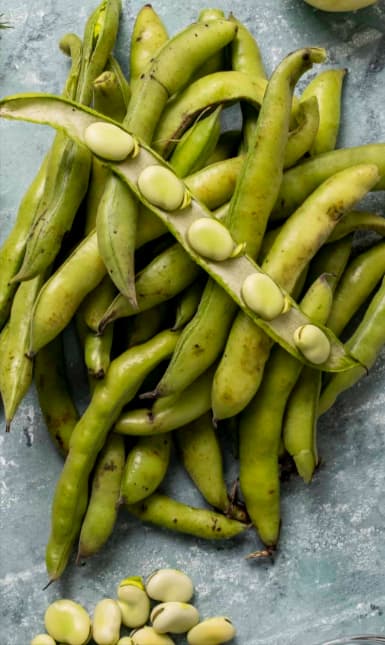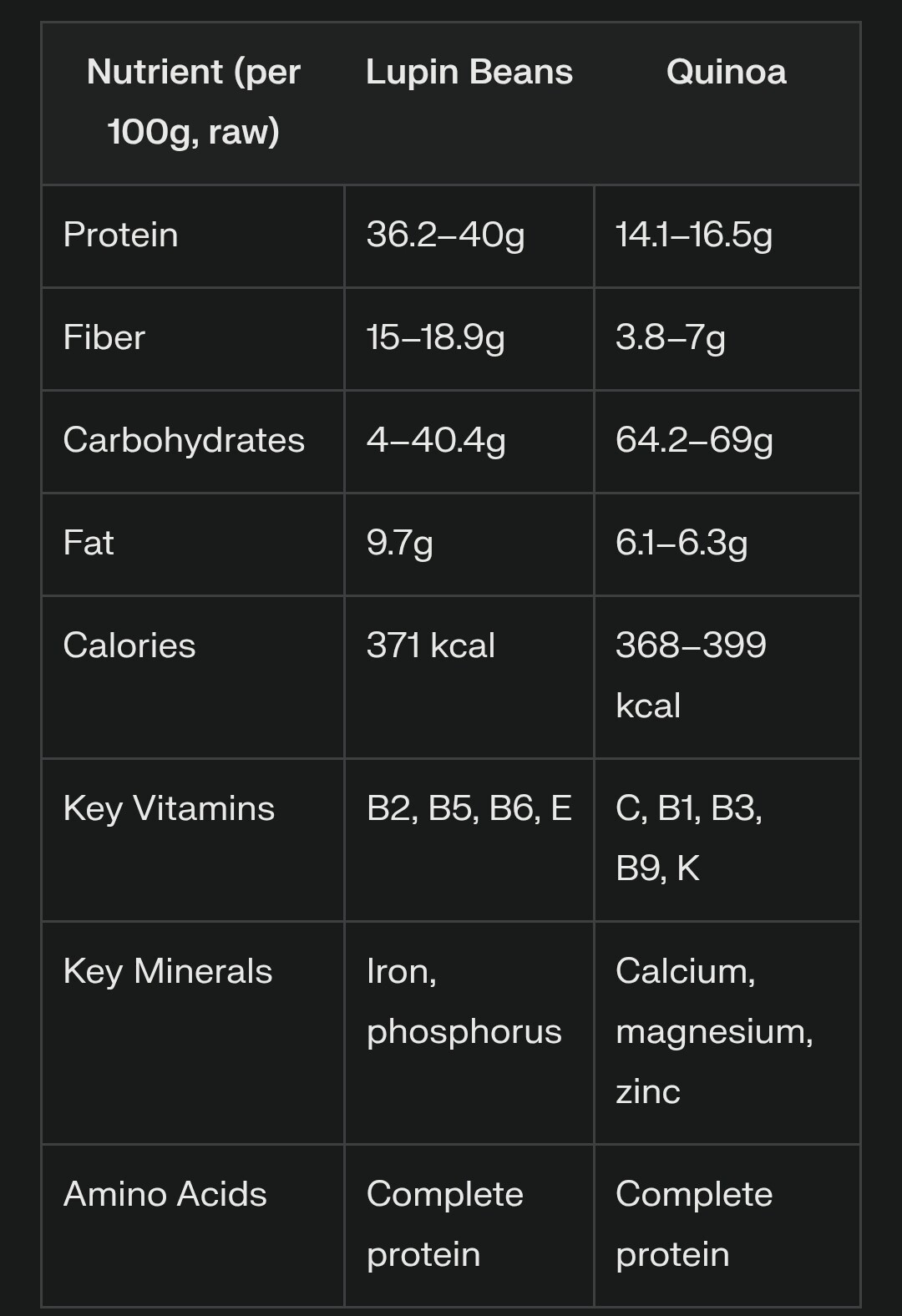Short answer: Yes—among common cereal grains, quinoa usually comes out on top for protein quality, several key micronutrients, and blood-sugar friendliness. It’s still “just a grain,” so beans beat it for protein, fiber, resistant starch, and most minerals, but if you’re choosing inside the grain family, quinoa is arguably the healthiest default.
1 Macronutrients (cooked, 100 g portions)
Food Calories Protein Fiber Complete essential-AA profile? Fat Quinoa 120 kcal 4.4 g 2.8 g Yes (all 9 EAAs) 1.9 g (Quinoa, cooked food comparison) Brown rice 111 kcal 2.3 g 1.8 g No (low lysine) 0.9 g (Calories in 100 G Brown Rice - Nutritionix) Oatmeal 62 kcal 2.6 g 1.7 g No (low lysine) 1.0 g (Calories in 100 g of Oatmeal and Nutrition Facts - FatSecret) (White rice, wheat berries, barley, etc. fall in the rice range for protein/fiber.)
Why quinoa wins here
- Nearly 2× the protein of brown rice and 50–90 % of the indispensable amino-acid pattern recommended by FAO, so vegetarians don’t need to “complement” it. (Quinoa, cooked food comparison)
- More fiber than most grains other than intact oats, which ties to better satiety and bowel health.
2 Micronutrient density
Nutrient (100 g cooked) Quinoa Brown rice Magnesium 64 mg 43 mg (Quinoa, cooked food comparison, What are the nutrition facts of brown rice 100 grams? - Reddit) Iron 1.5 mg 0.4–1.0 mg Folate 42 µg 9 µg Potassium 172 mg 44 mg Quinoa also brings notable manganese, phosphorus, copper, and some vitamin E. (Quinoa, cooked food comparison) Whole-grain rice and oats do contribute B-vitamins, but quinoa generally packs more per calorie.
3 Glycemic response
- Quinoa GI ≈ 35–53 (low) (Quinoa (cooked): glycemic index, glycemic load and nutrition facts, What is Quinoa’s Glycemic Index? Nutrition, Benefits, & Recipes)
- Brown rice GI ≈ 68 (medium-high); white rice ≈ 73–83 (high). (What is Quinoa’s Glycemic Index? Nutrition, Benefits, & Recipes)
Lower GI means slower, flatter post-meal blood-sugar and insulin curves—useful for insulin resistance or type-2-diabetes management.
4 Bioactive & health-outcome data
Recent systematic and clinical studies report that replacing refined or even other whole grains with quinoa:
- Lowers LDL-C and total cholesterol
- Slightly reduces fasting glucose and insulin
- Improves liver fat and inflammatory markers in NAFLD models (Unraveling the Role of Quinoa in Managing Metabolic Disorders, [PDF] The effect of replacing grains with quinoa on cardiometabolic risk …, The effect of replacing grains with quinoa on cardiometabolic risk …)
These effects are attributed to its mix of soluble fiber, polyphenols (esp. quercetin & kaempferol), and a better protein:carb ratio.
5 Anti-nutrients & “gotchas”
Factor Quinoa Typical cereals Saponins Higher; bitter taste if un-rinsed—can irritate gut lining in some people. Light rinse or buy “pre-washed.” (Evaluation of nutritional value, bioactivity and mineral content of …) Phytic acid 0.7 – 1.2 %—comparable to wheat & barley. (Classification, benefits, and applications of various anti-nutritional …) Oxalate 180–230 mg/100 g dry; a caution if you form calcium-oxalate kidney stones. (Nutritional Value and Bioactive Compounds of Leaves and Grains …) Gluten None (big advantage for celiac/gluten-sensitive folks) Wheat, barley, rye contain gluten Cooking or sprouting cuts saponins & phytate, and soaking/rinsing leaches some oxalate.
6 Beans vs. quinoa
- Protein: Beans ~7–9 g per 100 g cooked vs. quinoa’s 4 g.
- Fiber: Beans 6–8 g vs. 2–3 g.
- Resistant starch & butyrate production: Beans excel.
- Micronutrients: Beans usually win on potassium, magnesium, folate, and polyphenols.
- GI: Beans are very low (20–30).
So if you rank plant staples purely by metabolic and gut-health metrics, beans > quinoa > other grains.
7 Bottom line
Quinoa is the “nutrient-dense over-achiever” of the grain aisle: more and better protein, richer in key minerals, naturally gluten-free, and gentler on blood sugar. If you need a starch but don’t want glycemic spikes—or you’re boosting protein without gluten—subbing quinoa for rice, wheat, or corn is a solid upgrade.
Just remember:
- Rinse or buy pre-rinsed to remove saponins.
- If you have kidney-stone risk, keep portions moderate or pair with calcium-rich foods to bind oxalate.
- Beans still rule for protein and fiber—so build bowls with both for the best of all worlds.
-
Pretty sure Quinoa is a seed NOT grain.
-
It looks like per calorie oatmeal actually wins on the fiber and protein content (although not complete AAs).
You left out Amaranth. I grew it one year:
Both quinoa and amaranth are excellent choices, but their nutritional profiles have some key differences:
- Protein & Amino Acids: Both are complete protein sources, meaning they contain all nine essential amino acids. However, amaranth has slightly more protein per serving (about 9g per cooked cup) compared to quinoa (around 8g).
- Fiber: Amaranth is higher in fiber, which can aid digestion and help regulate blood sugar levels.
- Minerals: Amaranth is richer in calcium and iron, while quinoa has more potassium, zinc, and copper.
- Vitamins: Quinoa contains more Vitamin B1, B2, and E, making it beneficial for energy metabolism and antioxidant support.
If you’re looking for higher protein and fiber, amaranth might be the better choice. But if you want more vitamins and a lower glycemic index, quinoa could be preferable. Both are great options depending on your dietary goals!
Yup, botanically it is a seed and belongs to spinach family. It’s a pseudograin!
How were you cooking/consuming amaranth?
I use sprouted quinoa with my baluga lentil stew/soup with bunch of spices like black cumin, curry powder etc.
Chiming in with a recent personal take—and, I do realize fava beans are legumes, not grains, but had to share this experience because it feels relevant to anyone navigating grains and legumes.
I tried fava beans (broad beans) for the first time this week. As usual, I ran the nutrient profile through Cronometer and then cross-checked it with ChatGPT. That’s when I first learned about G6PD deficiency—a condition I hadn’t encountered before, and one not mentioned anywhere on the packaging.
According to ChatGPT, G6PD deficiency is the most common enzyme deficiency in the world, apparently affecting ~400 million people, particularly those of African, Mediterranean, or Asian descent. Most people with it are asymptomatic, but exposure to certain stressors—like infections, some medications, or eating fava beans—can trigger acute hemolytic anemia. That’s when red blood cells break down faster than the body can replace them, which can lead to fatigue, jaundice, or in rare cases, more severe outcomes (needing hospitalization).
Curious (and mildly alarmed), I dug into my WGS and—with ChatGPT’s help—searched for G6PD variants.
Thankfully, I don’t have any of the known risk alleles. Still, it struck me how easy it would be to miss this entirely.
If legumes are a regular part of your diet, it seems worth being mindful of!
That said—aside from fava beans—I agree with @AlexKChen : beans > grains when it comes to protein, fiber, polyphenols, potassium, and probably mineral levels.
And finally, brown rice—or really any rice with the bran layer still on (prob black and red) —would rank as my least healthy grain simply due to its propensity to accumulate arsenic.
fava beans ![]()

We actually popped it like popcorn. At the time I didn’t know much about sugar but that it tasted really good, so I used lots of oil and poured sugar in just before it started to pop. Easy to do and really sinfully good. It would air pop too and you can just sit around snacking.
To me amaranth tastes like it’s going bad. I always got a fungus flavor I didn’t really like. I wanted to try raising it with chemicals to get rid of the insect pests and maybe avoid fungus too? Never got around to it.
Has anyone tried Lupin beans (or its derivative Cho Cho protein powder).
Cho Cho protein mixes well in water.
Thinking of ordering lupin beans. They are gluten and leptin free as well.
@Nick1 I have a bag of Mikuna Cho Cho protein powder here. Unless I learn something new here today, I don’t plan to repurchase it. It’s much more expensive than my NorCal pea protein powder and I don’t prefer the taste. I discovered it at Erewhon, so I assumed if they used it in their smoothies, it must be amazzzzing. It has slightly less protein than Pea protein or kachava. I’ve also seen that lupin pasta is available. I eat a ton of lentil pasta (just to get extra protein in).
On that note, Kachava is much more expensive but to me it’s incredibly yummy.
@LongevityVault I live on legumes!
@Dr.Bart I’m today years old when learning per calorie oatmeal has more protein than quinoa. I don’t dislike quinoa, but I certainly don’t favor it, but continue to eat it for the protein (one less protein shake needed!). I’d much much rather have a bowl of oatmeal! Sigh, I guess I should still eat it for the amino acid profile…
I vote chia (20 chars 20 chars)
@John_Hemming my early Christmas present to you is my latest guilty pleasure. Note, you MUST make the lemon cashew cream topping… it’s what dreams are made of!
